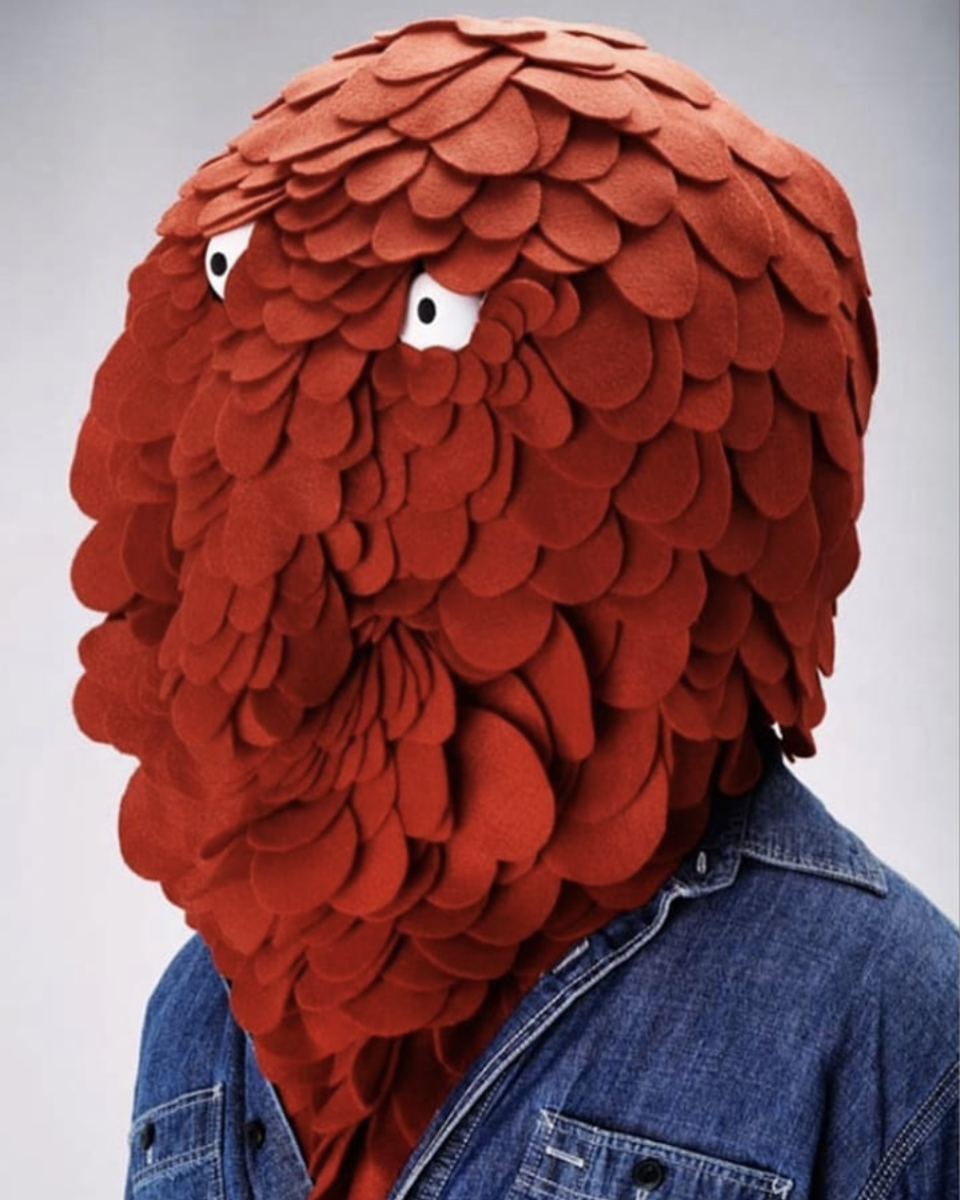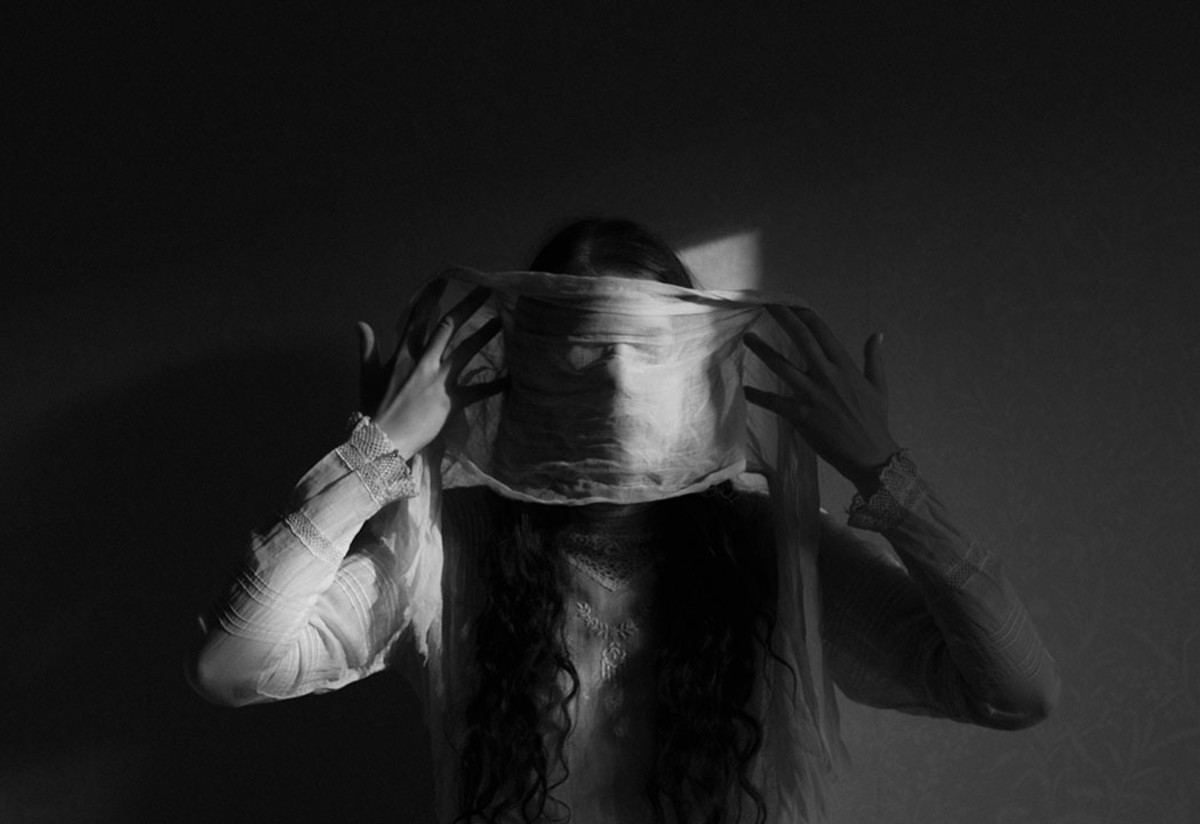False Face - Instagram
6. Annie Montgomerie’s Animal Figurines
I sometimes struggle with how to categorize pages as “bizarre,” especially when the page I’m looking at is artistic in nature. UK-based artist Annie Montomerie’s (@annie_montgomerie_art) Instagram posed that exact problem for me. Annie’s work is incredible, and for me, it’s very often unnerving how she captures such a dark and mysterious air through her humanoid depictions of animals. Her posse of characters tend to be a mix of animals wearing human articles of clothing. It gives us just enough to relate to them (in that they dress like us and often have facial expressions we can identify with), but still keep them mysterious. Truly, I love how she creates her figures from up-cycled fabrics and elements, making sure that each of her works is unique. Her pieces are fantastic and well worth a look, but after scrolling a bit through her page, I couldn’t help but feel a little odd looking at some of the photos, as her work tends to exude such a somber atmosphere. If you like what you see on her Instagram, be sure to check out her website, too! — Annie Montgomerie
5. @enmiljontystnader’s Haunting Black and White Photography
There’s something about black and white photography that, if done right, can easily warp our perception of when the photo was taken, giving them the chance to come off as distant, strange, and from a world we’re not at all accustomed to. Natalie’s (@enmiljontystnader) work exudes this very phenomena through her focus on strange and mysterious subjects and locations. There are so many things about the above photo that weird me out, like the disturbingly wide-eyed expressions of the woman in front, a feeling that’s even more exemplified by the unrecognizable figure behind her. I want to say his head is made of tree roots, but I can’t even be sure about that. What’s the relationship between these two figures? Tree Root Man has his hands wrapped around Wide Eyed Woman’s waist, and she’s not visually put off by this, so we can assume that their relationship is bordering on more than friends, and her wide-eyed expressions must be attributed to something completely different. These questions, along with the unnerving feeling Natalie’s work, is what makes her photography so intriguing. I appreciate the composition of her work so much, and she seems to compose her work effortlessly. The contrast between the figures is the most immediate quality (between their white and black outfits and faces), but something I really, really love about this image are the three trees behind the subjects. Each is pointing in a different direction, with their bases bringing our attention back to the center of the image where the subjects are. Most of all, the locations Natalie uses for her photography tend to be just as ambiguous as her subjects, which allows her to create a world of her own through her work, where her subjects can exist without interference of the world that we know around us.
4. Ronit Baranga’s Wild Sculptures
Just as with the other article I wrote on weird Instagram profiles, I think it needs to be said that being “bizarre” is in no way synonymous with being “bad.” A page’s bizarre content doesn’t have to be weird for the sake of being weird; it can be artistic and beautiful too, which are the exact descriptions that can be used when talking about Israeli scuptress Ronit Baranga’s (@ronitbaranga) work. The image above comes from Baranga’s sculpture series called “The Blurred Border Between the Living and the Still,” featuring silverware and dinnerware that have sprouted human fingers and mouths, allowing them to interact with one another. Ronit Baranga On her page dedicated to the project, Baranga states that, “In this combination of the still and the alive joined as one, I try to change the way in which we observe useful tableware. The useful, passive, tableware can now be perceived as an active object, aware of itself and its surroundings - responding to it. It does not allow to be taken for granted, to be used. It decides on its own how to behave in the situation. This is how I prefer to think about my plates and cups. Metaphorically, of course. What about you… ?” And what about you? Does Baranga’s work change the way you look at your own tableware? Maybe a couple more images will help cement her project into your mind! However, Baranga’s work isn’t focused solely on adding human features to inanimate objects. Another project she frequently produces work for, titled “The Grave Watcher’s Child,” features sculptures of demonic children, which Baranga states intrigues her because the fearful-looking creatures also exhibit traits of a time in human development where “innocence, sweetness, and playfulness were possible.” Ronit Baranga Ronit Baranga Baranga’s work is extraordinarily detailed, unnerving, and impressive. The amount of passion and thought she puts into her projects is admirable, and this is why you should be following her page! Ronit Baranga Ronit Baranga To learn more about Ronit Baranga and her work, check out the short docu-style video below.
3. Emil Melmoth’s Macabre Art
I wish I could take credit for describing Emil Melmoth’s (@emil_melmoth) art as “macabre” (that’s such a dope word), but I can’t. They specifically describe themselves on their Instagram as a “Mexican Artist focused on the Dark Surrealism and the Macabre Art.” Another sculptor, Melmoth’s work produces a significantly different tone than that of the previous entry, and it’s almost a complete opposite. The backgrounds are darker and the atmosphere of the pieces, while still being strange and unnerving, have a truly different feel than Baranga’s work. It’s interesting to note that a lot of his pieces exhibit a very Christ-like appearance. If they’re not sporting a makeshift crown make out of nails in their head, the subject’s hands or feed may be pierced with nails instead. Overall though, the dark and “macabre” tone of Melmoth’s work are, in my opinion, why you should be following his work!
2. @scioddities Curates Odd Scientific Curiosities
Sometimes the strangest things we encounter can be true to life, and that’s the entire purpose of Scioddities’ (@scioddities) page. To quote the page itself, in its contents you’ll be able to find “Medical curiosities, fine oddities, osteological preparations, anatomical models, scientific museums, natural science, wildlife - Tramond lover.” If you’re like me and have no idea what the heck a “Tramond” is, which is something Scioddities likes very much, your first inclination will probably be to Google the term to find out exactly what it is. But worry not, because I’ve already done that for you! According to the U.S. National Library of Medicine, a tramond is defined as “The technique of anatomical wax modelling reached its heyday in Italy during the 18th century, through a fruitful collaboration between sculptors and anatomists.” Okay, so the picture above is pretty weird. And if you haven’t checked out Scioddities’ page yet, take a look at the source post for the image above. The page goes in-depth on what exactly you’re looking at, which happens to be a wax replica of a hydrocephalic child. The post outlines the fact that it’s a condition where fluid builds up on the brain, and when it occurs in children, the effect can be a “rapid increase in head size”. Instagram - Scioddities If you take the time to read the post, you’ll see exactly why Scioddities is worth a follow. They’re incredibly passionate about their area of interest (medical an anatomical curiosities in this case), their posts exude their excitement and passion for the topic, and they’re laced with interesting information. In the case for the photo above, Scioddities notes that the specimen can be found in the Pathological Museum in the University of Florence. Their page is informative, weird, and fun, and I’d highly recommend giving them a follow if you’re really wanting to spice up that Instagram feed of yours!
1. @_false_face Makes Fake Faces
@_false_face is a project by artist Jym Davis, which aims to show “hidden faces from around the world.” Even though a lot of the masks are odd, what really makes his profile interesting is the fact that a majority of the features masks and images have heavy cultural background to them. Instagram - Scioddities Instagram - Scioddities While it’s interesting to see culturally-oriented masks featured through the page, it’s the more bizarre of the masks that pop up which truly capture my attention. If you take the time to look closely at them, it’s worth noting how intricate and complicated a lot of the masks are, which brings up something I hadn’t thought much about before coming across Jym’s IG. I never really considered masks as a potential art form before. False Face - Instagram I love finding people who excel in mediums that I’m not accustomed to seeing, and that’s only one of the many reasons I think you should be follow False Face on Instagram!
Go Forth and Explore!
So between this article and my previous one, you should have plenty of odd and bizarre content to be exploring and following! If you’re interested in exploring more accounts like the ones above, be sure to check out some of the related profiles that may be listed in the drop down menu next to the “follow” button on their Instagram pages. Again, while the content on these pages can seem odd or weird, many of them have substantial artistic merit to their work, and each one of them shows a passion for their area whether it’s sculptures or curating images of medical oddities. I think it’s healthy to switch up the content you see online every once in a while so you’re reminded that world isn’t all gorgeous landscapes and picture-perfect models living their “best lives”. Hopefully you’ve found some new people to follow after reading this article, and if not, I hope you were at least entertained while you were reading!





















